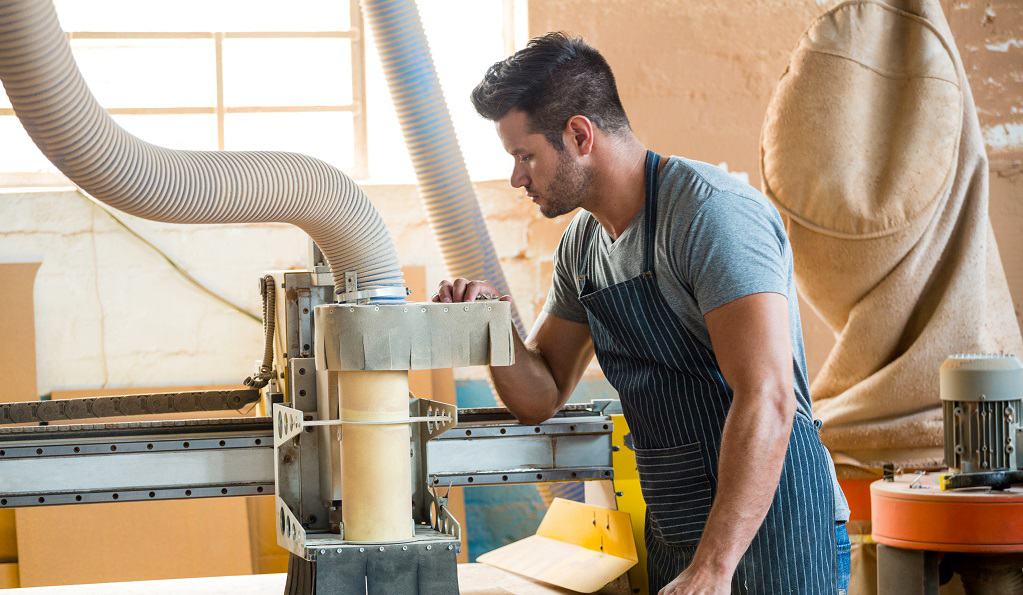One of the most trivial and cumbersome parts of having a workshop is the upkeep. Keeping the space clean and tidy is essential for a safe work environment.
An essential maintenance tool for upkeep with debris and harmful particles is a dust collector.
A dust collector has two jobs: to pull debris away from your machinery and to filter dust particles before recirculating air back into your workshop.
Choosing a dust collector can be quite cumbersome. Most laymen, let alone "experts" can't decipher airflow charts, types of dust collectors, or calculate for static pressure losses. Sound is also something to consider.
Let's take a look at your options.
This dust collector from Jet works on Vortex Cone technology. It is a system that gives you better chip separation, so you get less clogging and more packing efficiency in your collector bag.
It boasts a collection capacity of 5.3 cubic feet and a two-horsepower motor, which means you're getting a modern dust collector with impressive functionality.
It features a transparent dust bag which means you won't be changing the container more than you need to, and it also features a sewn-in snap ring so you can get the bag in and out with ease.
Four robust casters also make the dust collector quite mobile, which makes it easier to move it around. The quiet factor for this dust collector is also pretty solid, at 80 to 85 decibels, staying just below the harmful noise level.
The dust collector takes care of 96% of 30-micron particles, and its dual four-inch dust ports allow you to connect two machines at the same time.
It also features a fully enclosed, fan-cooled two-horsepower motor with continuous duty. This means there's more than enough horsepower to make sure you're getting efficient air movement.
Here we have the W1727, a safe and reliable entry from Shop Fox. One of the great things about this dust collector is its mobility, as the wheels on the bottom of the unit allow for a seamless transition from stationary to mobile, to the central dust collector.
The impressive portability paired with its small size (just 54.5 inches tall) makes this dust collector great for small spaces. However it's not exclusive to small workshops, as the high portability level can be appreciated in any setting, provided you have the hose to reach.
Rather than constructing an entire fixed system and running ducts all over your workshop, use the W1727 and smoothly glide from one machine to another to take care of your dust collecting needs.
This dust collector also has a decent noise rating, emitting just 79 to 81 decibels when in use, which is just under the harmful noise threshold of 85 decibels.
Not only is it safe for your ears, but it's safe in general. The W1727 has a safety switch with a removable key so you can defend against others using it without your permission or supervision.
The removable lock-out key paired with the oversized paddle switch offers a much safer experience over other 110-volt on/off switches. It's as simple as hitting the paddle down to switch off power.
If you're looking for a much more compact dust collector, you really can't go wrong with this option from PSI. It weighs in at just 25.4 pounds and measures 23" x 8" x 10.5" in size.
The smaller size and weight mean you can literally carry it anywhere you need it and put it safely on any workbench or table. This adaptability makes it great for power carving or sanding no matter where you are. PSI calls it a 'self-contained dust collection system.'
The DC725 by PSI draws dust particles in with its three computer-grade, maintenance-free fans. These innovatively-designed fans help keep the unit quieter than most shop vacs and dust collectors at just under 80 decibels.
That's pretty quiet for a dust collector, but still loud enough that you'll need to speak up a good deal if you're trying to carry on a conversation.
The fans, as well as the filter of the DC725, are built right into the portable cabinet, which features clear polycarbonate doors that can guide the air to give you optimal suction levels. The dust particles are caught by a 10 x 20-inch filter at 725 CFM, while the fans run on a 110V variable speed motor.
The 3410 3-speed by WEN might just be the crown jewel of this list. Like the offering from PSI, this model is exceedingly portable and versatile, but at almost half the price.
It's got a strong ⅙ HP motor, and it weighs in at just 31 pounds. The lightweight design paired with the carrying handle and eye-bolts might make this one even more mobile than PSI's model.
This WEN machine collects the air, puts it through a 5-micron outer filter, and a 1-micron inner filter, then releases it back into your workshop.
You can also choose between three speeds, either 300, 350, or 400 CFM, and use the time feature to easily set the timer to filter the air in the room at regular intervals.
The WEN 3410 also comes with a remote which allows you to control the dust collector from up to 26 feet away. Not to mention it's one of the quietest dust collectors on the market, emitting just 50 to 60 decibels.
Lastly, it's backed by a two-year warranty.
Shop Fox's model W1685 dust collector is a powerful machine with 1.5 horsepower, 110-volt, 3450 RPM single-phase motor with 16 amps.
Even with the larger motor, you're not losing much mobility as the 78-inch tall unit comes with a portable stand that goes 21.5 x 33.5 inches. This makes this unit much more mobile than its size might indicate.
This dust collector also boasts an extra-strong 12-inch steel impeller and works for wood dust only. Newer editions also come with a 2.5 micron felt upper filtration bag as well as a plastic lower collection bag.
Both of which can be purchased separately to fit with any dust collector that might not include them. The W1685 can also provide you with 1,280 CFM, 5.4 cubic feet of bag capacity, and 10.1 inches of static pressure. At 80-85 decibels, it's not the quietest however it's fairly quiet considering its size and power.
The W1685 also has a six-inch inlet that features removable Y-fitting with a pair of four-inch openings. Y-fitting can branch lines so you can service more than one machine, making this ideal for a multi-machine layout.

Before deciding on a certain type of dust collector it's important to evaluate what YOU need.
Without being super technical, your dust collector needs to pull more air (rated in CFM) than your most demanding tool (and it's adjoined ductwork) require.
For instance, the most air-hungry tools found in a home woodworkers shop are belt sanders and jointers. These tools typically require 500+ CFM.
Even if you don't currently have these tools, purchasing a larger dust collector allows you to purchase them in the future.
There are two types of dust collectors: single-stage and two-stage.
Most Woodworkers are familiar with two-bag, single-stage dust collectors.
These dust collectors work by transporting sawdust and wood chips through an impeller on the way to a collection bag.
The air exhausts through the filter bags and the heavier particles and debris then settle in the lower bag.
In a two-stage dust collector, the wood chips and heavier particles and debris fall out of the airflow in the first stage.
As a result, the finer dust particles pass through the impeller and into the filter (second stage). A two-stage collector can be as technical as a cyclone separator, or as simple as a garbage can with a snap-on lid placed before a single-stage collector.
Another important factor to consider is if you have the floor space and ceiling height for either of the options.
Space also factors in the portability of the equipment. If you plan to move the dust collector from machine to machine, you should have room for the machine and the hose.
If you opt for a stationary dust collector, you need ample room to run ductwork in the walls and the ceiling. Factors like duct length, material, and pathing are important. Meaning short-runs and smooth paths for optimal airflow.
You should also be strategic about the placement of machines like the sander, jointer, and planer so that they're closest to the dust collector.
In order to keep the wood chips, shavings, and dust moving through the systems ductwork, a duct collector has keep to a steady stream of air going through the system at a specific velocity.
This velocity is measured in feet per minute or FPM. The system also has to move a volume of air (considerable amount) which is then measured in cubic feet per minute or CFM.
This relationship between velocity and volume of air is directly affected by the size of the duct. As we noted above, factors like duct length, material, and pathing are all important. Meaning, larger ductwork results in a greater volume of air.
This is why we noted above, your dust collector needs to be able to pull more air than your most demanding tool.
An idea of CFM requirements:
| Machine | Required CFM |
|---|---|
| 10" Table Saw | 350-450 |
| Jointer (up to 8" wide) | 350-400 |
| 12" Planer | 500 |
| Planer 15"+ | 600-900 |
| Drill Press | 300 |
| Horizontal Belt Edge Sander | 550-600 |
Note: Manufacturers often specify the minimum CFM requirements for their power tools. Refer to your machines manual or manufacturers website for specific requirements.
It's important to reference CFM specifically as it's directly related to loudness or sones.
A sone is an internationally recognized unit used to measure loudness. Unlike a decibel, a sone is a linear unit of measurement. This means that by doubling the sone value for any given machine, you're effectively doubling its loudness.
A measurement of 1 sone would translate to a whisper. Where-as a measurement of 8 sones is the equivalent of a normal conversation.
Sones are measured at the maximum CFM value for dust collectors. Meaning, if you don't want to exceed a specific loudness factor, you should pick a machine that's rated at that sone value or the CFM value equivalent. Sones can also be converted from a decibel rating.
Typical decibel (dB) ratings for a dust collector are 50-80 dB or 5-39 sones.
Lastly, while being quiet in a space is essential for you and your neighbors, so is being safe. You shouldn't compromise your system by looking for a lower CFM. If your actively using machines that create large amounts of debris and particles, you need to make that a priority.

Dust particles that are smaller than 10 microns can pose a serious health risk (1). Your throat and nose both actively have defenses against airborne particles, however because of the small size of dust particles, they can slip past these defenses.
A dust collector should be able to pull away these small particles while still being able to contain them in the filter.
Most dust collectors will come outfitted with 30 micron bags which are too porous for finer particles. You should look for 1-micron filters and bags with 98% efficiency. If they don't come with your manufacturer, you can find bags elsewhere.
The safety of the air you breathe in your workshop should never be up for debate. While being quiet is beneficial for you and the people around you, never compromise CFM values to meet a specific dB or sones value.

Snoringsource.com is a participant in the Amazon Services LLC Associates Program, an affiliate advertising program designed to provide a means for website owners to earn advertising fees by advertising and linking to amazon(.com, .co.uk, .ca etc) and any other website that may be affiliated with Amazon Service LLC Associates Program.